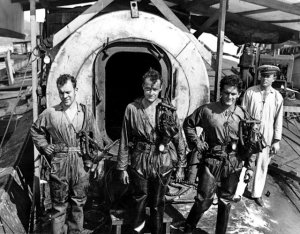![]() The Pacific War Online Encyclopedia
The Pacific War Online Encyclopedia
|
| Previous: Diver Class, U.S. Rescue And Salvage Ships | Table of Contents | Next: Division |

Wallin (1968). Via ibiblio.org.
Divers are men trained and equipped to work underwater for extended periods of time. They could perform repairs below the waterlines of ships, were essential to salvage of ships sunk in shallow water (as at Pearl Harbor), and could retrieve documents and equipment from sunken enemy ships that had considerable intelligence value. During the Pacific War, divers did not generally engage in combat operations. Underwater Demolition Teams were not equipped with breathing apparatus and operated mostly at the water's surface, submerging for only brief periods of time to place explosives on obstacles.
A trained diver can hold his breath for a period in excess of five minutes, a risky practice sufficient for only the briefest underwater activities. Thus extended underwater activity requires that the diver be equipped with an artificial oxygen supply. The first self-contained underwater breathing apparatus (SCUBA) were developed as early as 1917, but these were just becoming practical when war broke out, and professional and military divers generally used an air line to the surface to provide oxygen.
The human body is normally lighter than water, and
this buoyancy requires considerable effort for a diver to overcome. As
a result, diving dress included ballast to neutralize buoyancy.
A serious risk with deep dives is decompression sickness, also known as "the bends." This occurs when nitrogen dissolves in the blood under high pressure, then forms bubbles when the pressure is suddenly reduced, as when a diver returns to the surface too quickly. These bubbles could damage tissues and interfere with the circulation of the blood, producing excruciating pain and partial paralysis. By the time war broke out in the Pacific, the navies of the major powers had worked out diving tables specifying the maximum safe rate of ascent for divers returning to the surface from various depths and after various durations of time underwater. The general rule of thumb was that a diver should not ascend more rapidly than about 30 feet (10 meters) per minute, but slower ascents were necessary following longer dives or repeated dives on the same day.
Another risk with prolonged deep dives was nitrogen narcosis, in which nitrogen dissolved in the blood at high pressure begins to alter brain function. The use of helium-oxygen mixtures to prevent nitrogen narcosis was pioneered by the U.S. Navy diver team that rescued the crew of submarine Squalus from over 200 feet (110 meters) of water in 1939.
Divers played a major role in the salvage of the battleships sunk at Pearl Harbor during the Japanese attack on 7 December 1941. The divers patched holes or placed cofferdams to restore watertight integrity and allow the ships to be pumped out and refloated. Divers from submarine tender Holland had inspected the sunken remains of I-124 off Darwin. Divers also scored a major intelligence coup in Manila Bay by retrieving highly classified Japanese documents from the cruiser Nachi, which was sunk in about 100 feet (30 meters) of water.
In preparation for the anticipated Allied invasion, the Japanese Navy began training about 4000 fukuryu or "crouching dragon" units. These were divers, many in their mid-teens, who were expected to destroy Allied landing craft (and themselves) with pole charges. These divers were equipped with rubber suits and a simple rebreather, a form of breathing apparatus that recycled air exhaled by the diver by passing it through caustic lye (sodium hydroxide, NaOH) to remove carbon dioxide. These lacked proper valves, so that trainees had to remember to exhale through their mouths and inhale through their nostrils or risk inhaling caustic lye. One survivor of the program recalled that over half his group of trainees perishing in training accidents. The pole charges supplied to the fukuryu were approximately 11'(3.34m) long and were tipped with a small mine (Attack Mine Type 5) with a small explosive charge and a buoyancy chamber to improve underwater handling.
References
divesafety.net (accessed 2011-10-12)
Wallin (1968; accessed 2011-10-12)
The Pacific War Online Encyclopedia © 2011, 2014-2015 by Kent G. Budge. Index